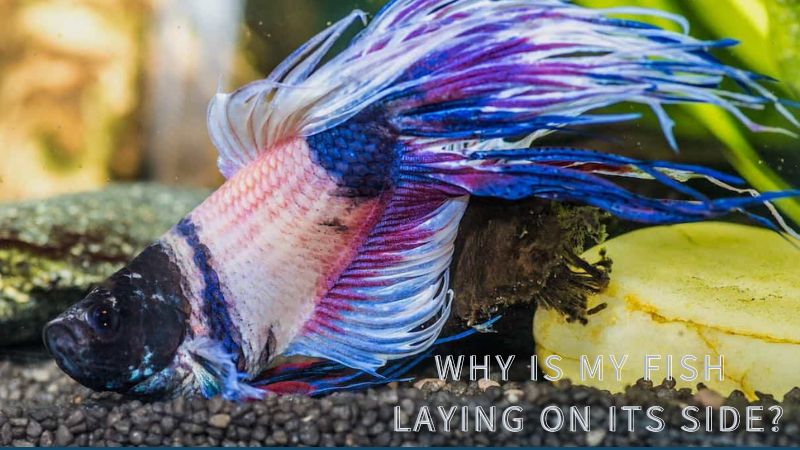Seeing your fish lying listlessly on its side is a cause for concern. This behavior can indicate a variety of underlying issues, ranging from water quality problems to swim bladder disease. A prompt diagnosis and proper treatment are crucial for your fish’s health. This article Tropical Fish Haven will explore the hidden reasons behind the question why is my fish laying on its side?
Why is my fish laying on its side?
There are a few reasons why your fish might be lying on its side at the bottom of the tank. Here are some possibilities:
- Swim bladder disease: This is a common issue where the fish loses buoyancy control. They may float upside down, struggle to stay upright, or sink to the bottom.
- Water quality issues: Ammonia spikes, nitrites, or improper pH levels can all stress fish and make them lethargic.
- Stress: New tank introductions, tank mates bullying, or loud noises can stress fish.
- Injury or illness: Physical damage or internal illness can cause swimming difficulties.
How to handle fish lying on its side
Check Water Parameters: Test the water parameters (ammonia, nitrites, nitrates, pH, temperature) to ensure they are within appropriate ranges for your fish species.
Inspect for Signs of Disease: Look for any other symptoms such as changes in color, lesions, or unusual behavior that might indicate a disease or infection.
Isolate the Fish: If possible, move the affected fish to a quarantine tank to prevent potential spread of disease and to provide a more controlled environment for treatment.
Feeding and Fasting: Sometimes, fasting the fish for a day or two can help alleviate swim bladder issues, as can feeding them foods that act as natural laxatives, like thawed peas (with the skins removed).
Consult a Veterinarian: If the issue persists or if you suspect a serious health problem, consult a veterinarian who specializes in fish or an experienced aquarist for further diagnosis and treatment advice.
Taking prompt action can improve the chances of restoring your fish’s health and well-being.
Air bubble structure
The air bubble is a part of the fish’s embryonic development, developing from a sac in the digestive tract. Most fish’s air bladder consists of two parts, the one near the head, which is tightly attached to the spine. The second part is the part near the tail
By using air pressure regulators, fish can adjust the amount of air in the bladder, thereby helping them float or sink to the bottom easily.
Symptoms of fish suffering from air bubble disease
Below are some symptoms that show your fish is suffering from air bubble disease:
- Fish continuously swim to the surface of the water
- Fish swim sideways
- The fish lies at the bottom of the tank, possibly lying on its back
- The fish swims with its head down
- The fish is rotated
- The fish’s belly is clearly bulging (the scales may or may not be ruffled and pointing outward).
- Fish stopped eating
How to prevent fish from getting air bubble disease
Feed the fish the right food
Some types of dry fish food will be low in fiber, so you need to feed your fish a diverse diet, including green vegetables if possible, to avoid constipation.
A diverse diet for fish will include regular dry food to ensure basic nutrition for the fish, along with frozen foods for worms, artemia, etc. and occasionally you should also feed them. Fish eat more green vegetables. In addition to diet, providing them with enough space to operate also helps prevent this disease. Bettas kept in small spaces for a long time are also susceptible to intestinal diseases.
In short, if you want your fish to live healthy, you need to feed them a nutritious diet, buy good quality fish food, and occasionally provide them with fresh foods. and green vegetables.
Water quality
Dirty and polluted water is the main cause that can cause stress in fish and weaken their immune system. So you need to clean and change the water for the tank by 10%-15% of the water every week. Once every two weeks, if possible, use suction tubes to suck up fish feces and leftover food residue at the bottom of the tank.
Above all, use a filter with suitable filter material with good flow to achieve a stable microflora in the tank.
Keep the environment stable
The aquarium must be stable in both water quality and temperature. You need to avoid changing too much water in the tank at once and causing the water temperature in the tank to change too quickly. Once the tank has been fully cycled and stabilized, the fish will never get sick and will always be healthy.
Avoid keeping too many fish
If you keep too many fish in the tank and some of them are too aggressive, it can cause some other fish to become stressed.
Above all, if the tank has a lot of fish and the filter is not capable of handling the excess waste, it will seriously affect the water quality in the tank.
Avoid overfeeding your fish
Overfeeding your fish can cause uneaten food to accumulate at the bottom of the tank and affect water quality. Above all, if you feed your fish too much poor-quality food, it can affect the fish’s digestive tract and make them malnourished.
You should feed your fish a diverse diet, alternating dry and fresh food and only feed the fish enough food to eat within 3 minutes. You should also starve your fish one day per week to help them consume undigested food.
Conclusion
By observing your fish and its environment, testing your water, and taking appropriate action, you can increase your fish’s chances of recovery. Remember, if your fish doesn’t show improvement within a day or two, consulting a veterinarian or experienced aquarist is vital for a proper diagnosis and targeted treatment plan. With a little investigation and care, you can get your fish back to swimming happily in no time.





